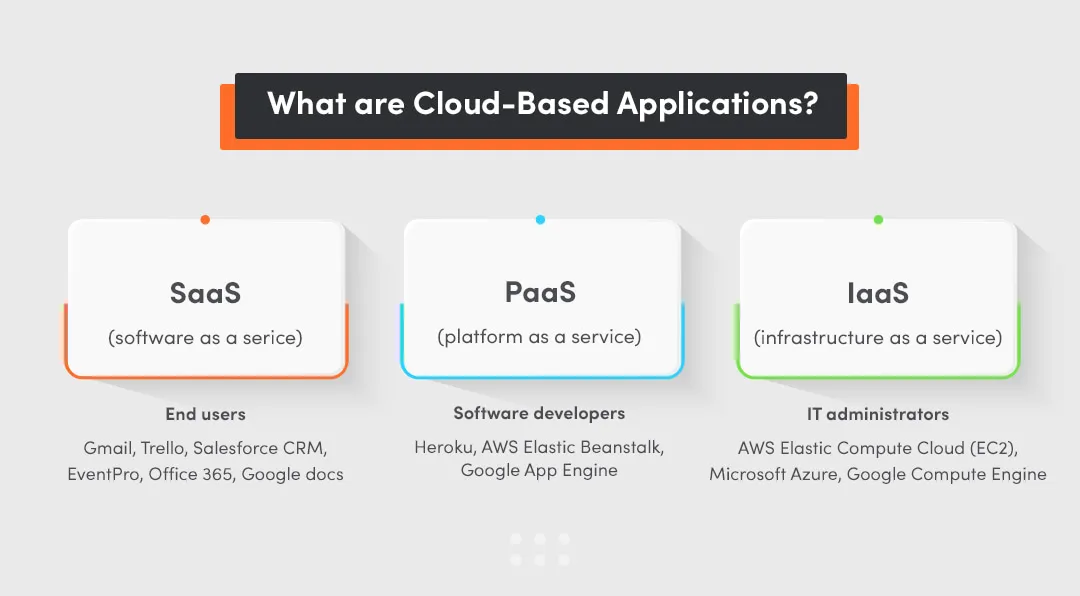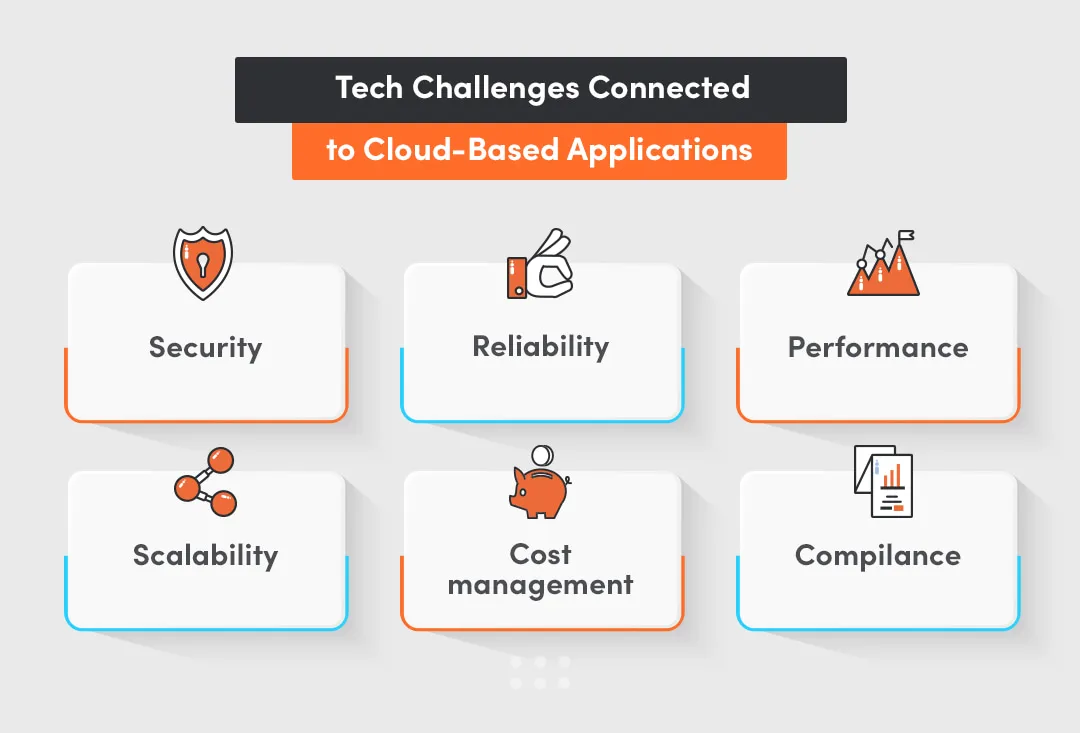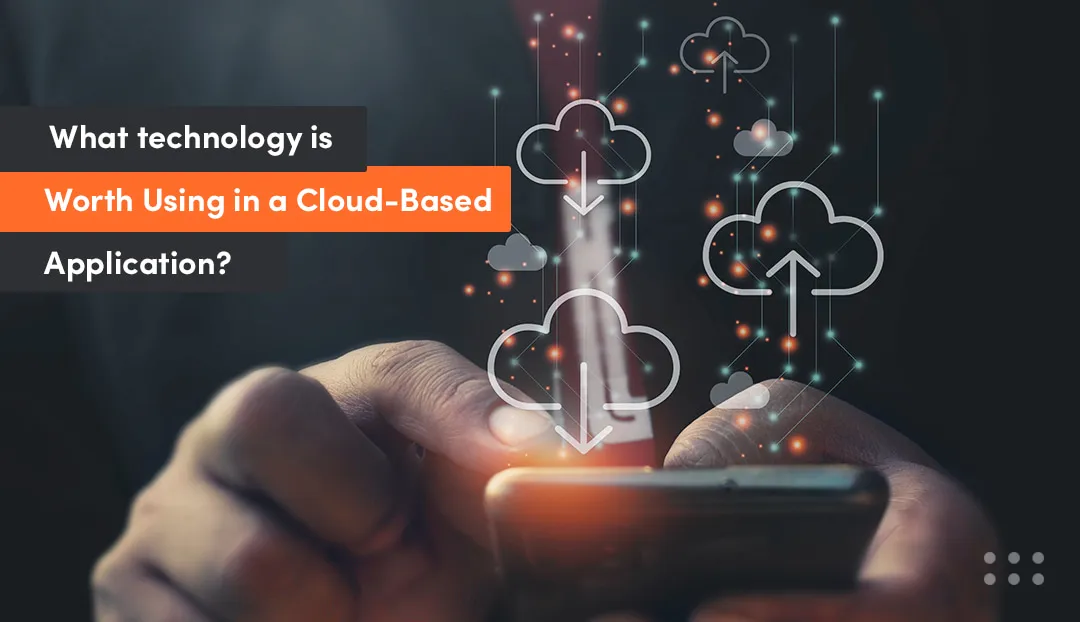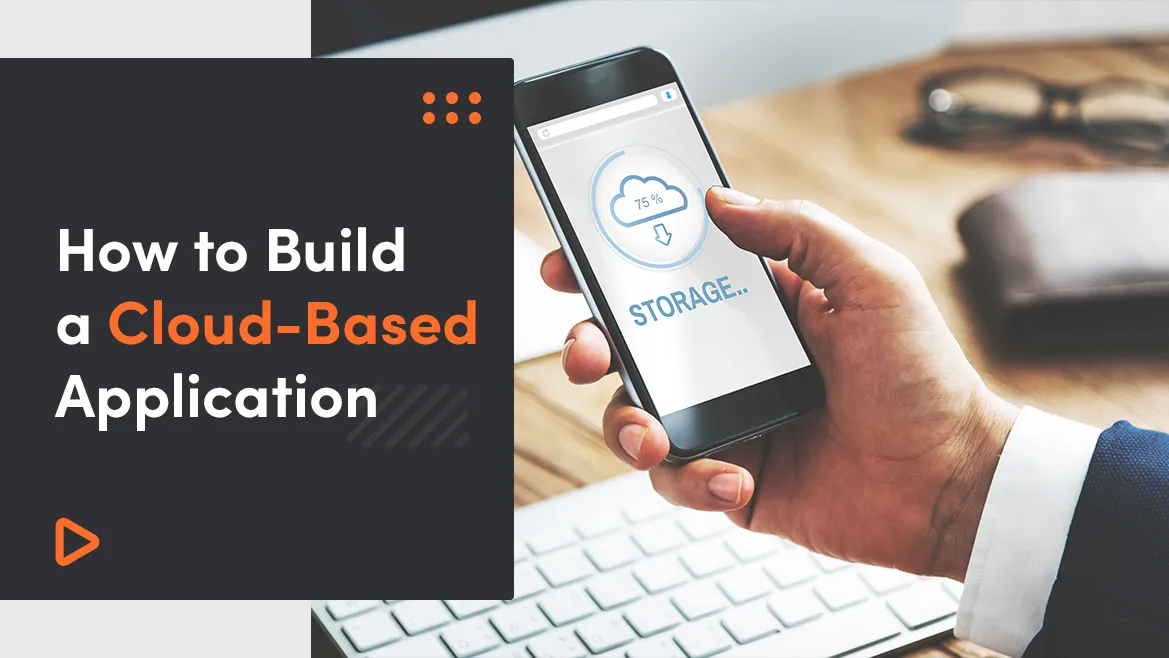Cloud computing generally refers to two distinct concepts. The most common understanding involves running workloads remotely over the internet in a commercial provider's data center, such as Amazon Web Services (AWS), Microsoft Azure, or Google Cloud Platform (GCP).
The second meaning focuses on the technical aspect, describing cloud computing as a virtual pool of resources that can be accessed on demand.
Cloud computing has become so integral that most new applications are designed with cloud environments as the preferred deployment option. To ensure your business remains competitive, it’s essential to consider building a cloud-based or cloud-computing application development side. But where should you start?
What will you learn from this article?
- What are the possible types of cloud apps?
- Which technologies work best for such cloud solutions?
- What are the technology challenges of cloud app development?
- How to choose technology for developing cloud-based applications?
What Are Cloud-Based Applications?
Cloud-based applications function by leveraging external servers to handle computing and storage tasks. Users access and interact with these applications over the internet, usually through a web-based interface. Well-known examples include Google Docs and Office 365, both of which require only a web browser and an internet connection.

While numerous cloud computing services exist, they generally fall into one of the following categories:
Types of Cloud Services
SaaS (Software as a Service): SaaS allows users to access software through a web browser or API without needing to download, install, or run it locally on a computer. The key benefits of SaaS include easy accessibility, broad compatibility, and reduced operational management overhead. Additionally, users always have access to the latest software version. However, SaaS typically requires a constant internet connection, which may be a limitation, although this is increasingly less of an issue with widespread broadband access.
Read also: How To Design A SaaS Application?
IaaS (Infrastructure as a Service): IaaS offers essential computing, networking, and storage resources over the internet on a pay-as-you-go basis. This service provides the highest level of control over cloud resources while minimizing the operational complexities associated with traditional infrastructure management. IaaS is particularly useful for businesses needing flexible and scalable cloud infrastructure.
PaaS (Platform as a Service): PaaS delivers a complete development and deployment environment in the cloud, allowing developers to build applications without managing the underlying infrastructure. It is typically billed based on the consumption of resources, making it an efficient solution for application development.
Cloud Deployment Models
Public cloud: In a public cloud, services and infrastructure are managed by a third-party provider and shared among multiple organizations.
- Examples: AWS, Azure, Google Cloud.
- Benefits: Cost-efficiency, scalability, and ease of management.
Private cloud: A private cloud is dedicated to a single organization, with services and infrastructure maintained on a private network.
- Examples: VMware, OpenStack.
- Benefits: Enhanced security, control, and customization.
Hybrid cloud: A hybrid cloud combines public and private clouds, enabling data and applications to be shared between them.
- Benefits: Flexibility, optimized workloads, and balanced cost and security.
Multi-cloud: Multi-cloud involves using multiple cloud services from different providers.
- Benefits: Avoids vendor lock-in, leverages best-of-breed solutions, and improves resilience.
Understanding these fundamental concepts and cloud deployment models is crucial for making informed decisions about the best approach for your cloud-based application. This knowledge ensures that you select the appropriate service type and deployment model to meet your specific needs and objectives.
Planning Your Cloud-Based Application
Define Your Objectives
Understanding the Purpose and Goals of Your Application:
- Clearly outline what you aim to achieve with your cloud-based application.
- Determine the target audience and their specific needs.
- Establish the primary functions and features of the application.
Identify Requirements
Technical Requirements:
- Specify the technical specifications needed to build the application, such as programming languages, frameworks, and tools.
- Identify the infrastructure requirements, including servers, databases, and network configurations.
Functional Requirements:
- List the core functionalities that the application must provide, such as user authentication, data processing, and reporting.
- Determine any specific business logic or processes that need to be incorporated.
Non-Functional Requirements:
- Security: Outline the security measures that need to be implemented to protect data and ensure user privacy.
- Scalability: Define how the application should handle growth in users and data volume.
- Performance: Establish performance benchmarks, such as response times and throughput.
- Reliability: Determine the availability and fault-tolerance requirements to ensure continuous operation.
Choosing the Right Cloud Service Provider
Comparison of Major Providers:
- Evaluate the leading cloud service providers: Amazon Web Services (AWS), Microsoft Azure, and Google Cloud Platform (GCP).
- Compare their offerings in terms of compute power, storage options, networking capabilities, and additional services.
Criteria for Selection:
- Cost: Analyze the pricing models and costs associated with each provider, including upfront costs, pay-as-you-go options, and long-term savings.
- Features: Look at the specific features and services offered by each provider that align with your application's needs.
- Support: Assess the level of customer support and technical assistance provided, including documentation, community forums, and dedicated support plans.
By meticulously planning these aspects, you lay a strong foundation for the successful development of a cloud-based application. Proper planning helps you make informed decisions, mitigate risks, and ensure that the application meets its objectives while performing efficiently in the cloud environment.
Try our developers.
Free for 2 weeks.
No risk. Just results. Get a feel for our process, speed, and quality — work with our developers for a trial sprint and see why global companies choose Selleo.
Tech challenges connected to cloud-based applications

The Flexera State of the Cloud Report offers valuable insights into the current state of cloud computing, highlighting trends, strategies, and usage patterns. In 2023, the survey gathered responses from 750 global cloud decision-makers and users, capturing their perspectives on the private, public, and multi-cloud markets.
You can read more about it in How To Meet GDPR Requirements In Mobile And Web Applications.
How to select a cloud app development company?
It should not be a surprise that many businesses decide to outsource the development of their cloud applications to external providers. You can read more about it in our post Top SaaS Companies That Outsourced Software Development. But how to choose an outsourcing provider?
- Define a clear scope of work
The first step to take before you start the collaboration is to declare what you need. Find the best solution that can be adjusted to your requirements and prepare the scope of the project. It may also be valuable to prepare a detailed description of the MVP - see: What Does MVP Stand for in Business and Why Is It Important in Software Projects?
- Establish industry experience
When you are looking for the right partner, search for teams that have previous experience in developing a similar product to what you wish to create. Research also the technologies best-suited to your app.
- Check the market reputation
Before signing the contract, check the reputation of your provider. Make use of public catalogues like GoodFirms or Clutch, which usually contain previous client’s reviews.
- Ask for client references and sample code
Do not be afraid to ask for the company’s references and portfolio. You can also ask them for feedback on the presented project scope.
- Check the financial stability
One last thing to remember when looking for an outsourcing partner is checking if the company is reliable and financially stable. Make sure the developers will be 100% available when you need them.
What technology is worth using in a cloud app?

When developing a cloud-based application, selecting the right technology stack is crucial. Each technology offers distinct benefits, so it's important to thoroughly evaluate your project's requirements before making a decision.
React
React is a popular JavaScript library designed for building user interfaces. It leverages a Virtual DOM, which significantly enhances application performance. One key advantage of React is its unidirectional data flow, where components are nested within parent components. This structure simplifies debugging when issues arise. Additionally, React promotes code reusability through its component-based architecture, which can accelerate development time. React is versatile, supporting both web and mobile applications, and with React Native, you can reuse some of the code to develop mobile solutions.
Ember
Ember is an open-source JavaScript framework licensed under the MIT License. It features the Glimmer rendering engine, which greatly improves rendering speed. Ember's comprehensive ecosystem includes a vast array of out-of-the-box addons, making it a powerful tool for developers. Furthermore, Ember provides a Command Line Interface (CLI) utility that integrates Ember-specific patterns into the development process, prioritizing developer productivity.
Elixir
Elixir is a relatively new programming language, particularly well-suited for applications that require high scalability and performance, such as heavily trafficked websites. Elixir supports concurrency, enabling multiple processes to run simultaneously and handle numerous requests concurrently. Running on the Erlang Virtual Machine, Elixir can operate across multiple nodes, facilitating the creation of larger networks and improving application performance. Elixir also boasts high fault tolerance, ensuring applications remain operational even in the event of errors. Phoenix, a popular framework for Elixir, supports real-time processing on the server side, complementing JavaScript.
Ruby on Rails
Ruby on Rails (RoR) is a well-established web application framework that follows the Model-View-Controller (MVC) architectural pattern, one of the most widely used in application development. The Active Record library in RoR simplifies database interactions, often eliminating the need to write SQL queries manually. RoR adheres to the "convention over configuration" principle, which reduces the need for extensive configuration files. Debugging is straightforward in RoR, as it provides detailed error logs.
Node.js
Node.js is a high-performance, server-side platform built on Google Chrome's V8 JavaScript engine. Node.js features asynchronous APIs, meaning the execution of one command doesn't block the execution of the next, which enhances efficiency. Applications built with Node.js do not buffer data; instead, they output it in chunks. Node.js is highly scalable due to its use of a single-threaded, event-loop architecture, which can offer better performance than traditional servers like Apache.
How to develop a cloud-based app development? - the road to follow
Creating a cloud-based application involves a series of crucial steps and best practices. Here’s a roadmap to help you build a robust cloud-ready solution:
- 1. Design it as a collection of services
For optimal performance in cloud-based software, design your application as a collection of independent services or APIs. Each service should be capable of functioning independently, without relying on data from other services. This modular approach not only enhances performance but also allows for easy reuse of individual components in future projects or new modules.
- 2. Decoupled data
A key best practice is to separate the data layer from the application logic. By decoupling these elements, you can improve the efficiency of data processing in the cloud. Pay special attention to the performance of your database operations, as all interactions will occur over the internet, which can introduce latency. Implementing caching systems can significantly enhance the speed and responsiveness of your application.
- 3. Communication between the components
When designing your software, carefully consider how components will communicate with each other. In scenarios where constant communication is unnecessary, it may be more efficient to transmit larger batches of data at once rather than making frequent requests for small updates. This approach can reduce the overhead and improve overall system performance.
- 4. Design for failure
Cloud applications may experience downtime or disruptions. To mitigate this risk, design your application with redundancy in mind. Implement a paired topology for critical components so that if one part fails, its counterpart can handle the traffic and maintain service continuity.
- 5. Prepare for Load Variance
As your user base grows, so will the traffic to your application. Design your solution to be scalable, allowing for the dynamic allocation of additional resources during peak usage periods and the ability to scale down when demand decreases. This flexibility ensures your application remains responsive and cost-efficient under varying loads.
Conclusions
Cloud computing allows businesses to run applications remotely using providers like AWS, Azure, or Google Cloud. This article guides the development of cloud-based applications, discussing types of cloud services (SaaS, IaaS, PaaS), cloud deployment models (public, private, hybrid, multi-cloud), and the essential planning steps, such as defining objectives, identifying technical and functional requirements, and selecting the right cloud service provider.
Key technology challenges include security risks, reliability, performance, scalability, cost management, and compliance with regulations like GDPR. To develop a successful cloud app, businesses should carefully choose their technology stack (e.g., React, Ember, Elixir, Ruby on Rails, Node.js) and follow best practices, including designing the app as a collection of services, decoupling data, optimizing communication, designing for failure, and preparing for load variance.
For outsourcing development, businesses should define a clear scope of work, verify the provider's experience, reputation, and financial stability, and consider client references. This strategic approach ensures the creation of efficient, scalable, and secure cloud-based applications.
To build a cloud computing infrastructure, start by selecting a cloud service provider, such as AWS, Azure, or Google Cloud, based on your specific needs and budget. Design the architecture, including components like virtual machines, storage, and networks, ensuring scalability and redundancy for reliability. Implement security measures, including firewalls, encryption, and identity management, to protect data and resources. Set up automation tools for deployment, monitoring, and scaling to maintain efficiency and minimize manual intervention. Finally, continuously monitor and optimize the infrastructure to ensure it meets performance and cost-effectiveness goals.
A cloud-based application is software that runs on remote servers rather than on a local computer or device. Users access these applications over the internet through a web browser or a dedicated app, which means they don't need to install or maintain the software on their own devices. Cloud-based applications are scalable, allowing users to easily increase or decrease resources based on demand. They also offer the advantage of being accessible from anywhere with an internet connection, providing flexibility and convenience. Additionally, cloud-based applications often include automatic updates and backups, reducing the need for manual maintenance.
Cloud application development has several pitfalls that developers need to be mindful of. First, vendor lock-in can be a significant issue, where applications become heavily dependent on a particular cloud provider's services, making it difficult to switch providers later. Second, security and compliance challenges arise, as sensitive data must be protected according to various regulations, which can be complex in cloud environments. Third, cost management can be tricky, as unexpected usage spikes or poorly optimized resources may lead to unforeseen expenses. Finally, performance issues, such as latency and availability, can affect the user experience if the cloud infrastructure is not properly managed or the application is not well-architected for scalability.





